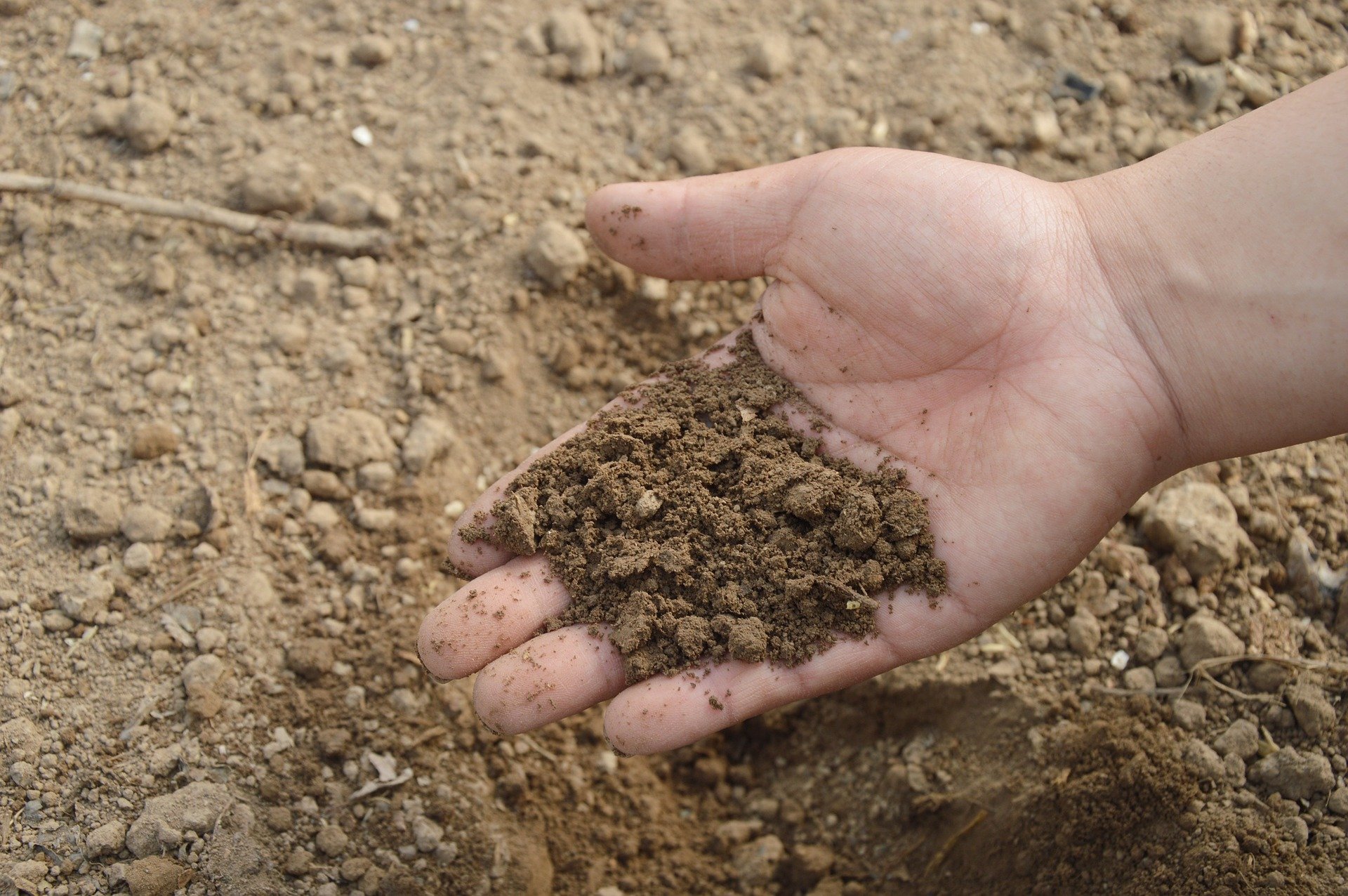Have you ever observed that your garden soil sometimes seems to repel water, rather than absorbing it so that your plants can take it up via their roots? If so, you might be wondering why this happens. What makes soil go hydrophobic and how can you fix this so that it takes in water as it should?
There are a number of reasons that your soil might turn hydrophobic, including long periods without rain, too much tilling, lack of nutrients, waxy barriers, and high temperatures. The fixes will depend on what has caused the issue, but may include using a wetting agent, improving the soil health, regular watering, and adding good compost to the soil.
What Is Hydrophobic Soil?
Hydrophobic soil is the term for soil that will not absorb moisture. Usually, when you water the soil or it rains, this water is very quickly soaked into the ground, and it is then available to plants, which suck it up via their roots as and when they need it.
If the soil has become hydrophobic, however, it is not taking the water in. Instead, the water will sit on the surface, or run off if it is on a slope. This is a big problem, as it leaves plants parched and unable to find a drink, so you need to determine the cause and fix it swiftly if your plants are to survive.
What Causes Hydrophobic Soil?
There are quite a few conditions that can contribute to hydrophobia in your soil, but we’ll cover some of the common ones below. Note that several of these features may combine to cause increased hydrophobia; the solution may need to address more than one issue at a time.
Drought
So, the first thing that can cause hydrophobic soil is long periods of drought, which dries the soil thoroughly. High temperatures can affect the organic content of the soil and make it less capable of taking in moisture.
Soil Disturbance
Alternatively, this water-repelling property may be caused by too much disturbance and regular soil tilling. If you disturb the soil’s natural structure very frequently, it may lose its ability to absorb water properly.
Try to avoid disrupting your soil too often. It is thought that doing so – while unavoidable at times – is damaging to the soil and the microbes that live in it. While turning and aerating compacted soil can be helpful, over-processing will stop your soil from absorbing water.
Old Soil
You may also notice that if your soil is very old and has been depleted of its nutrients by lots of plants without being fertilized, it does not absorb water well. This is because the soil is not well balanced, and so its structure has been upset. It cannot hold onto water properly, and water tends to sit on the surface.
Waxy Barrier
It’s possible that you have observed a waxy barrier on the surface of your soil, and this is one of the commonest reasons for hydrophobia. This waxy layer usually forms as organic matter breaks down into the soil, leaving the waxes and oils that it contained on the surface.
In normal conditions, this will wash into the soil and slowly disperse, causing no harm. However, if there has been a distinct lack of rain, the oils may build up on the surface, slowly forming a layer of wax that prevents the next rains from soaking in properly.
This has a cumulative effect and depending on how dense the layer is, you may notice that it is seriously water repellent. A thin layer will usually allow some water to permeate, but a thick layer can be almost waterproof and will cause the water to stay on the surface.
Soils with low surface area are far more vulnerable to being coated like this, so if you have sandy soil, watch out for this waxy residue building up. Clay, with a bigger surface area, should not suffer from the problem as readily.
There are certain kinds of microorganisms that can degrade the waxes left behind by decaying plants more quickly, and sometimes adjusting the pH of your soil may help to encourage these microbes. They often prefer slightly alkaline conditions.
How Can You Fix Hydrophobic Soil?
The first thing to do is insert a moisture probe into your soil to see how serious the issue is. If your soil is only slightly water repellent, it should prove easier to fix, whereas seriously hydrophobic soil is going to need a lot of work to restore it to its normal state.
Next, you need to pinpoint the cause of the issue to ensure that you are fixing the problem, not just randomly changing your soil conditions. Knowing what has caused the hydrophobia will make it easier to fix.
Add Compost
The first thing you should do is check whether your soil is depleted and needs compost or mulch to replenish its nutrients. Compost is good at retaining moisture and it will improve the soil structure, making it better at absorbing water, so it is a good and simple way to fix soil hydrophobia.
Try mulching your soil with fresh compost, or use a soil test kit to see whether it is deficient in certain nutrients. It is often a good idea to test your soil whenever you encounter a problem, as this can be an inexpensive way to identify issues so you can fix them effectively.
Prime The Soil
Alternatively, try priming your soil. To do this, you are going to regularly sprinkle the soil with water and then cover it with a layer of straw. This will help to trap the water against the soil and encourage absorption.
This will take a while to work, but should gradually increase the absorbency of the soil. Keep working at this, or combine it with other methods to increase its effectiveness.
Use A Wetting Agent
If you’re really struggling with soil hydrophobia, you may need to buy a commercial wetting agent in order to fix the issue. These are specifically designed to help the moisture from rainwater soak into the ground.
There are many kinds available, and they work by sifting down into the soil and then absorbing moisture themselves. This surpasses the waxy layer, and as water is restored to the area, microbes may become more capable of breaking it down. It will also help your plants to access water in the interim.
Be aware that wetting agents are only a temporary fix to the problem, and they will not really solve the issues listed as causing hydrophobia. Poor soil quality, waxiness, excessive tilling, and drought can only be solved by addressing the issues at their core, and wetting agents treat the symptoms, rather than curing the problem.
Add Worms
You can easily purchase worms online, and having plenty in your soil is a good way to keep it healthy and aerated. The worms will burrow around, breaking up compaction, and as they come to the surface to find food, they should help to disrupt any waxiness.
They will also replenish the goodness in your soil, especially if you provide them with food to break down. They will pull this under the surface and spread its nutrients around through the ground. This solves issues with old soil and helps to rebalance the nutrients.
Their presence – or the increase in food – might also help to encourage microbes, some of which will reduce the waxiness. All in all, worms are essential to good soil health, and healthy soil absorbs water effectively. Worms aren’t a direct solution to hydrophobia, but they can certainly help.
Don’t Disturb The Soil
As mentioned, tilling the soil too much can spoil its water absorbency and disrupt the microbes that keep it healthy and balanced, so try not to keep disturbing the soil when you don’t have to. It is much better to leave it, and let natural processes such as worms turn and aerate compacted parts where possible.
Obviously, sometimes you do need to dig up the soil, especially if you are growing vegetables. However, it is worth being aware of the impact that this can have, and limiting the process where possible. Unturned soil may be healthier and happier.
Make Flat Beds
Sloped beds tend to dry out more quickly than flat ones because the water will all run to the bottom. This also causes the nutrients to wash down, leaving poor soil near the top. It will become prone to drought and may lose its structure.
If you make your flowerbeds flat, they will be far more capable of retaining their moisture and the water will have more time to soak in evenly, rather than flowing down.
Conclusion: What Causes Hydrophobic Soil?
There are quite a few causes of hydrophobic soil, but a very common one is the waxy residue left by decomposing plant matter. If you have a lot of leaves decaying on the surface of your soil, particularly from certain plants such as lupins and clovers, you may need to take action to decrease hydrophobia and ensure that the soil soaks up moisture effectively.



